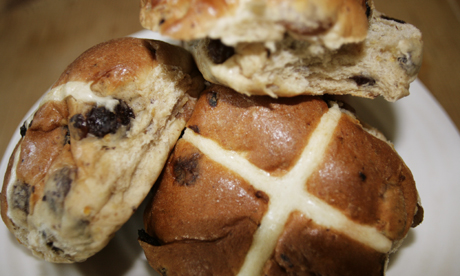Consider the hot cross bun

Hot cross buns. Photograph: Hackney Citizen
In America a “bun” is any kind of bread roll, but it has a more specific meaning here as a spiced and sweetened miniature loaf. Buns are some of the best things to have emerged from English kitchens. In no other country did they become such an art. They emerged in modern form in the late 1600s, as spices and sugar from the new world became cheaper and the middle class swelled.
The “London bun” was finger-shaped, covered in white icing and flavoured with currants and caraway seeds. It sounds like it’s well due a revival. Bath buns are made from an especially rich dough similar to brioche, and sprinkled with crushed sugar lumps. Chelsea buns are one of the loveliest: the Bun House of Chelsea began producing them in the early 1700s, and the same establishment sold a great deal of hot cross buns.
The OED’s first reference to HCBs dates to 1733 and the familiar nursery rhyme, but the buns are far older than that. The Ancient Greeks baked small loaves to mark the spring, and even the Egyptians offered breads marked with the image of ox horns to their goddess of the moon. When archaeologists excavated the Roman city of Herculaneum – buried by the same explosion that preserved Pompei – they found two small, carbonised loaves among the ruins, each marked with a cross. The pagan Saxons baked breads slashed with crosses to honour Eostre, their goddess of spring and fertility and the source of our word Easter. The four sections symbolised the four quarters of the moon, or the seasons, or something else.
The truth is that the cross is such a common, ancient sign it can represent almost anything. And since one can yoke so many meanings to the symbol, breads decorated with it have developed an exceptional number of superstitions and legends. It was popularly believed that a bun baked on Good Friday would never go mouldy, that if it was hung in the kitchen it would improve a cook’s baking and prevent fires from breaking out, and that if you stashed a bun in a heap of corn it would keep the rats and weevils away. One Lincolnshire family has apparently kept a hot cross bun in a box since 1821.
Sailors, always a superstitious lot, took buns to sea hoping they might ward off shipwreck. There’s a pub in the East End called The Widow’s Son, named after a woman who lived on the site in the 1820s and who baked some hot cross buns for her son who was due home from sea that day. He never arrived, but she continued to bake a bun for him every year and hang it in the kitchen. Every Good Friday, a dozen or so members of the Royal Navy present the pub with a large hot cross bun in memory of the lost sailor, and the pub tells me it lays on free hot cross buns and other food for anyone who drops in for a drink.
The first crossed bread in Christian mythology may be the rather limp story of St Clare of Assisi, who blessed a loaf of stale bread in the presence of Pope Gregory IX and, lo, a cross did miraculously appear on it. A couple of years ago a C of E spokesman suggested to the BBC that in addition to the cross and the communion-ish bread, the bun’s spices “represent the spices Jesus was wrapped in in the tomb” – this sounds to me like the most inventive piece of retcon.
Elizabeth David wrote that in 1592, some time after the Reformation, Elizabeth I restricted London bakeries from making crossed buns “except it be at burials, or on Friday before Easter, or at Christmas”. And no doubt this cemented the tradition of eating crossed buns at this time of year; Boswell wrote in 1773: “Being Good Friday I breakfasted with him and cross-buns.”
Today, though, hot cross buns are in the shops more or less all year round, and are probably the most popular buns in the country. Tesco sells 70m a year. Felicity is perfecting the best recipe for them as we speak, but I’m keen to hear your thoughts on how one should ideally enjoy them. I like mine toasted and buttered, but believe jam to be utterly de trop. I’m also highly sceptical of the Australian tendency – now aped by Waitrose – to pellet them with chocolate. How do you like yours?
guardian.co.uk © Guardian News & Media Limited 2010
Published via the Guardian News Feed plugin for WordPress.
